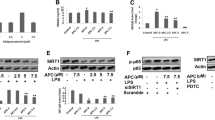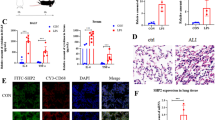Abstract
The pharmacotherapeutic mechanism of colchicine, a tricyclic, lipid-soluble alkaloid extracted from the plant of the Lily family Colchicum autumnale, has not been fully understood in diverse disorders, including sepsis-induced acute lung injury (ALI). The study aimed at exploring the impact of colchicine on sepsis-induced ALI and the relevant mechanisms. Colchicine significantly attenuated ALI in mice caused by sepsis by alleviating respiratory dysfunction and pulmonary edema in mice, inhibiting NLRP3 inflammasome formation, and reducing oxidative stress, pyroptosis, and apoptosis of murine alveolar macrophage (J774A.1) cells. The targets of colchicine were predicted in the superPRED database and intersected with the differentially expressed genes in the GSE5883 and GSE129775 datasets. The major targets were subjected to protein–protein interaction network generation and Kyoto Encyclopedia of Genes and Genomes enrichment analysis. It was thus found that colchicine inhibited STAT3 phosphorylation but did not alter STAT3 total protein expression. Phosphorylated STAT3 recruited EP300 to form a complex to promote histone H3 acetylation and histone H4 acetylation of NLRP3 promoter, leading to pyroptosis of J774A.1 cells. In conclusion, inhibition of STAT3 phosphorylation by colchicine represses NLRP3 promoter acetylation via the STAT3/EP300 complex, thereby alleviating ALI caused by sepsis.







Similar content being viewed by others
Data availability
The data that support the findings of this study are available from the corresponding author upon reasonable request.
References
Aggarwal NR, King LS, D’Alessio FR (2014) Diverse macrophage populations mediate acute lung inflammation and resolution. Am J Physiol Lung Cell Mol Physiol 306:L709-725. https://doi.org/10.1152/ajplung.00341.2013
Cao F et al (2020) Suppression of NLRP3 inflammasome by erythropoietin via the EPOR/JAK2/STAT3 pathway contributes to attenuation of acute lung injury in mice. Front Pharmacol 11:306. https://doi.org/10.3389/fphar.2020.00306
Deftereos SG et al (2022) Colchicine in cardiovascular disease: in-depth review. Circulation 145:61–78. https://doi.org/10.1161/CIRCULATIONAHA.121.056171
Domscheit H, Hegeman MA, Carvalho N, Spieth PM (2020) Molecular dynamics of lipopolysaccharide-induced lung injury in rodents. Front Physiol 11:36. https://doi.org/10.3389/fphys.2020.00036
Gotts JE, Matthay MA (2016) Sepsis: pathophysiology and clinical management. BMJ 353:i1585. https://doi.org/10.1136/bmj.i1585
Jiang L et al (2020) Sodium butyrate alleviates lipopolysaccharide-induced inflammatory responses by down-regulation of NF-kappaB, NLRP3 signaling pathway, and activating histone acetylation in bovine macrophages. Front Vet Sci 7:579674. https://doi.org/10.3389/fvets.2020.579674
Kamitani S et al (2011) Kruppel-associated box-associated protein 1 negatively regulates TNF-alpha-induced NF-kappaB transcriptional activity by influencing the interactions among STAT3, p300, and NF-kappaB/p65. J Immunol 187:2476–2483. https://doi.org/10.4049/jimmunol.1003243
Korkmaz S, Erturan I, Naziroglu M, Uguz AC, Cig B, Ovey IS (2011) Colchicine modulates oxidative stress in serum and neutrophil of patients with Behcet disease through regulation of Ca(2)(+) release and antioxidant system. J Membr Biol 244:113–120. https://doi.org/10.1007/s00232-011-9404-4
Lai Y, Li J, Li X, Zou C (2017) Lipopolysaccharide modulates p300 and Sirt1 to promote PRMT1 stability via an SCF(Fbxl17)-recognized acetyldegron. J Cell Sci 130:3578–3587. https://doi.org/10.1242/jcs.206904
Lelubre C, Vincent JL (2018) Mechanisms and treatment of organ failure in sepsis. Nat Rev Nephrol 14:417–427. https://doi.org/10.1038/s41581-018-0005-7
Leung YY, Yao Hui LL, Kraus VB (2015) Colchicine-update on mechanisms of action and therapeutic uses. Semin Arthritis Rheum 45:341–350. https://doi.org/10.1016/j.semarthrit.2015.06.013
Liu CC et al (2018) Upregulation of NLRP3 via STAT3-dependent histone acetylation contributes to painful neuropathy induced by bortezomib. Exp Neurol 302:104–111. https://doi.org/10.1016/j.expneurol.2018.01.011
Martinez GJ, Celermajer DS, Patel S (2018) The NLRP3 inflammasome and the emerging role of colchicine to inhibit atherosclerosis-associated inflammation. Atherosclerosis 269:262–271. https://doi.org/10.1016/j.atherosclerosis.2017.12.027
Martinon F, Petrilli V, Mayor A, Tardivel A, Tschopp J (2006) Gout-associated uric acid crystals activate the NALP3 inflammasome. Nature 440:237–241. https://doi.org/10.1038/nature04516
Nakashima K et al (1999) Synergistic signaling in fetal brain by STAT3-Smad1 complex bridged by p300. Science 284:479–482. https://doi.org/10.1126/science.284.5413.479
Robertson S, Martinez GJ, Payet CA, Barraclough JY, Celermajer DS, Bursill C, Patel S (2016) Colchicine therapy in acute coronary syndrome patients acts on caspase-1 to suppress NLRP3 inflammasome monocyte activation. Clin Sci (Lond) 130:1237–1246. https://doi.org/10.1042/CS20160090
Sadowitz B, Roy S, Gatto LA, Habashi N, Nieman G (2011) Lung injury induced by sepsis: lessons learned from large animal models and future directions for treatment. Expert Rev Anti Infect Ther 9:1169–1178. https://doi.org/10.1586/eri.11.141
Wu Q et al (2020) Colchicine prevents atrial fibrillation promotion by inhibiting IL-1beta-induced IL-6 release and atrial fibrosis in the rat sterile pericarditis model. Biomed Pharmacother 129:110384. https://doi.org/10.1016/j.biopha.2020.110384
Yang M et al (2020) Colchicine alleviates cholesterol crystal-induced endothelial cell pyroptosis through activating AMPK/SIRT1 pathway. Oxid Med Cell Longev 2020:9173530. https://doi.org/10.1155/2020/9173530
Yue Q, Liu T, Cheng Z (2020) Protective effect of colchicine on LPS-induced lung injury in rats via inhibition of P-38, ERK1/2, and JNK activation. Pharmacology 105:639–644. https://doi.org/10.1159/000504759
Zhai W et al (2021) CREPT/RPRD1B promotes tumorigenesis through STAT3-driven gene transcription in a p300-dependent manner. Br J Cancer 124:1437–1448. https://doi.org/10.1038/s41416-021-01269-1
Zhang L, Jin S, Wang C, Jiang R, Wan J (2010) Histone deacetylase inhibitors attenuate acute lung injury during cecal ligation and puncture-induced polymicrobial sepsis. World J Surg 34:1676–1683. https://doi.org/10.1007/s00268-010-0493-5
Zhang ZT, Zhang DY, Xie K, Wang CJ, Xu F (2021) Luteolin activates Tregs to promote IL-10 expression and alleviating caspase-11-dependent pyroptosis in sepsis-induced lung injury. Int Immunopharmacol 99:107914. https://doi.org/10.1016/j.intimp.2021.107914
Zhang D, Li L, Li J, Wei Y, Tang J, Man X, Liu F (2022) Colchicine improves severe acute pancreatitis-induced acute lung injury by suppressing inflammation, apoptosis and oxidative stress in rats. Biomed Pharmacother 153:113461. https://doi.org/10.1016/j.biopha.2022.113461
Zhao J et al (2016) Protective effect of suppressing STAT3 activity in LPS-induced acute lung injury. Am J Physiol Lung Cell Mol Physiol 311:L868–L880. https://doi.org/10.1152/ajplung.00281.2016
Zhu H et al (2021) Janus kinase inhibition ameliorates ischemic stroke injury and neuroinflammation through reducing NLRP3 inflammasome activation via JAK2/STAT3 pathway inhibition. Front Immunol 12:714943. https://doi.org/10.3389/fimmu.2021.714943
Acknowledgements
Thanks to Haitao Li, Yan Zhang, Yanhui Cui, Chao Song, Fengyu Lin, and Yi Li for their constructive suggestions and help to the author in the process of experiment and manuscript writing.
Funding
This work was supported by the National Natural Science Foundation of China (No. 81770080); the Xiangya Hospital-Beida Weiming Clinical Rehabilitation Research Fund (No. XYWM2015I20); the Ministry of Science and Technology of the People’s Republic of China (No. 2016YFC1304204); Peking Union Medical Foundation—Ruiyi Emergency Medical Research Fund (No. R2021004) and Hainan Provincial Medical and Health Research Project (No. 20A200340).
Author information
Authors and Affiliations
Contributions
YSL Contributed to the conception and design of the work, drafted the manuscript, and performed most of the experiments. HY, FZ, YHOY, and PHP Contributed to analyzing data, revising the manuscript critically, and performing some of the experiments. All authors have read and approved the final manuscript.
Corresponding author
Ethics declarations
Conflict of interest
The authors declare that they have no competing interests.
Ethical approval
The experimental procedure was conducted following the Guidelines for the Care and Use of Laboratory Animals and permitted by the Ethics Committee of Central South University (Approval number: CSU-2022-0335).
Consent for publication
Not applicable.
Additional information
Publisher's Note
Springer Nature remains neutral with regard to jurisdictional claims in published maps and institutional affiliations.
Rights and permissions
Springer Nature or its licensor (e.g. a society or other partner) holds exclusive rights to this article under a publishing agreement with the author(s) or other rightsholder(s); author self-archiving of the accepted manuscript version of this article is solely governed by the terms of such publishing agreement and applicable law.
About this article
Cite this article
Liu, Y., Yang, H., Zhu, F. et al. Inhibition of STAT3 phosphorylation by colchicine regulates NLRP3 activation to alleviate sepsis-induced acute lung injury. Inflammopharmacol 31, 2007–2021 (2023). https://doi.org/10.1007/s10787-023-01199-9
Received:
Accepted:
Published:
Issue Date:
DOI: https://doi.org/10.1007/s10787-023-01199-9




